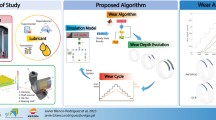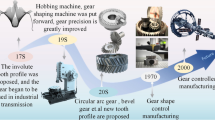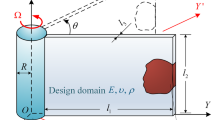Abstract
In the assembly process of aeroengine, the aeroengines have been rejected at pass-off test for high vibration of high-pressure rotor under the condition of meeting the geometric accuracy. Repeated disassembly and trial assembly will lead to interface damage, which will affect the safety and reliability of the engine. Therefore, a multi-objective collaborative optimization process method for geometric accuracy and dynamic performance is put forward based on the practical engineering problems. In the proposed method, the primal problem firstly reveals the transfer mechanism of coaxiality and unbalance of rotor system, and the prediction model of the coaxiality and unbalance of the rotor system was established. Then, combined with the high-precision reduced-order model of aeroengine high-pressure combined rotor, the system vibration responses under different assembly states are obtained. Finally, a multi-objective collaborative optimization assembly process method considering coaxiality, unbalance and vibration response is obtained. The results show that the collaborative optimization process method considering assembly accuracy and dynamic performance is the optimal assembly strategy, which can reduce the vibration amplitude of the key nodes of the rotor system while ensuring high assembly accuracy and achieve the low-level vibration of the rotor system.









Similar content being viewed by others
Data Availability
The datasets obtained during the current work are available from the corresponding authors upon request.
Code availability
Not applicable.
References
Kang HS et al (2016) Smart manufacturing: past research, present findings, and future directions. Int J Precis Eng Manuf Green Technol 3(1):111–128
Wang S, Lee C, Gunawan H et al (2021) On-line error-matching measurement and compensation method for a precision machining production line. Int J Precis Eng Manuf Green Technol 9:493–505
Bourdet P, Mathieu L, Lartigue C et al (1996) The concept of small displacement torsor in metrology. Adv Math App Sci 40:110–122
Whitney DE, Gilbert OL, Jastrzebski M (1994) Representation of geometric variations using matrix transforms for statistical tolerance analysis in assemblies. Res Eng Design 6(4):191–210
Whitney DE (2004) Mechanical assemblies. Oxford University, London
Zhao Q, Guo J, Hong J et al (2019) Analysis of angular errors of the planar multi-closed-loop deployable mechanism with link deviations and revolute joint clearances. Aerosp Sci Technol 87(4):25–36
Yu D, Zhao Q, Guo J et al (2021) Accuracy analysis of spatial overconstrained extendible support structures considering geometric errors, joint clearances and link flexibility. Aerosp Sci Technol 119(3):107098
Sun J, Shao L, Fu L et al (2020) Kinematic analysis and optimal design of a novel parallel pointing mechanism. Aerosp Sci Technol 104(10):105931
Vignat F, Villeneuve F (2003) 3D transfer of tolerances using a SDT approach: application to turning process. J Comput Inf Sci Eng 3(1):45–53
Asante JN (2009) A small displacement torsor model for tolerance analysis in a workpiece-fixture assembly. Proc Inst Mech Eng, Part B: J Eng Manuf 223(8):1005–1020
Camelio J, Hu S, Ceglarek D (2003) Modeling variation propagation of multi-station assembly systems with compliant parts. J Mech Des 125(4):673–681
Ghie W, Laperriere L, Desrochers A (2010) Statistical tolerance analysis using the unified Jacobian-Torsor model. Int J Prod Res 48(15):4609–4630
Li H, Zhu H, Li P et al (2014) Tolerance analysis of mechanical assemblies based on small displacement torsor and deviation propagation theories. Int J Adv Manuf Technol 72(1–4):89–99
Mu X, Sun Q, Sun W et al (2018) 3D tolerance modeling and geometric precision analysis of plane features for flexible parts. Eng Comput 35(7):2557–2576
Sun W, Mu X, Sun Q et al (2018) Analysis and optimization of assembly precision-cost model based on 3D tolerance expression. Assem Autom 38(4):497–510
Zhao B, Wang Y, Sun Q et al (2021) Monomer model: an integrated characterization method of geometrical deviations for assembly accuracy analysis. Assem Autom 41(4):514–523
Matsuura S, Shinozaki N (2011) Optimal process design in selective assembly when components with smaller variance are manufactured at three shifted means. Int J Prod Res 49(2–4):869–882
You Y, Jung SN (2017) Optimum active twist input scenario for performance improvement and vibration reduction of a helicopter rotor. Aerosp Sci Technol 63:18–32
Hernández S, Menga E, Moledo S et al (2017) Optimization approach for identification of dynamic parameters of localized joints of aircraft assembled structures. Aerosp Sci Technol 69:538–549
Rao SS, Wu W (2005) Optimum tolerance allocation in mechanical assemblies using an interval method. Eng Optim 37(3):237–257
Yang Z, Mcwilliam S, Popov AA et al (2013) Dimensional variation propagation analysis in straight-build mechanical assemblies using a probabilistic approach. J Manuf Syst 32(2):348–356
Yang Z, Popov AA, Mcwilliam S (2012) Variation propagation control in mechanical assembly of cylindrical components. J Manuf Syst 31(2):162–176
Wang L, Sun C, Tan J et al (2015) Improvement of location and orientation tolerances propagation control in cylindrical components assembly using stack-build assembly technique. Assem Autom 35:358–366
Liu Y, Zhang M, Sun C et al (2019) A method to minimize stage-by-stage initial unbalance in the aero engine assembly of multistage rotors. Aerosp Sci Technol 85(2):270–276
Sun C, Hu M, Liu Y et al (2019) A method to control the amount of unbalance propagation in precise cylindrical components assembly. Proc Inst Mech Eng Part B-J Eng Manuf 233(13):2458–2468
Zhou T, Gao H (2021) Modeling and simulation of the assembly accuracy of aero-engine rotors in the docking processes using a specially designed novel multi-DOF NC motion platform. Aerosp Sci Technol 113:106648
Gruen A, Akca D (2005) Least squares 3D surface and curve matching. J Photogramm Remote Sens 59(3):151–174
Hu W, Liu J, Jiang K et al (2013) Assembly precision prediction method for spacecraft based on 3D model. Comput Integr Manuf Syst 19(5):990–999
Qin ZY, Han QK, Chu FL (2014) Analytical model of bolted disk-drum joints and its application to dynamic analysis of jointed rotor. Proc Inst Mech Eng C J Mech Eng Sci 228(4):646–663
Qin Z, Han Q, Chu F (2016) Bolt loosening at rotating joint interface and its influence on rotor dynamics. Eng Fail Anal 59:456–466
Sun W, Li T, Yang D et al (2020) Dynamic investigation of aeroengine high pressure rotor system considering assembly characteristics of bolted joints. Eng Fail Anal 112:104510
Li T, Yang D, Zhao B et al (2021) Measured and investigated nonlinear dynamics parameters on bolted flange joints of combined rotor. J Mech Sci Technol 35(5):1841–1850
Funding
The work was supported by Foundation of He’nan Educational Committee, China (23B460001), the National Natural Science Foundation of China (51975539) and partly by the Key Science and Technique R&D Program of Henan Province, China (212102210275). The authors also wish to thank them for their financial support.
Author information
Authors and Affiliations
Contributions
All authors contributed to the study conception and design.
Tao Li: established the dynamic model of rotor connection considering assembly error, proposed a multi-objective collaborative optimization model for geometric accuracy and dynamic performance, and drafted the manuscript.
Zhenhua Wen: planned and coordinated the research project and its funding and summarized the current situation and the existing problems about assembly of rotating combined rotor system.
Binbin Zhao: proposed the accuracy prediction model of error and unbalance of typical bolted combined rotor and participated in the verification of accuracy prediction model.
Qingchao Sun: carried out the experimental verification of the theoretical model and analyzed and discussed the experimental results.
Corresponding authors
Ethics declarations
Ethics approval
Not applicable.
Consent to participate
Not applicable.
Consent for publication
The authors will either grant the publisher an exclusive licence to publish the article or agree to transfer copyright of the article to the publisher.
Competing interests
The authors declare no conflict of interest.
Disclaimer
The authors declare that the paper is original and has been written based on the own finding. It is confirmed that all the authors are aware and satisfied of the authorship order and correspondence of the paper.
The submitted work has not been published elsewhere in any form or language.
Additional information
Publisher's note
Springer Nature remains neutral with regard to jurisdictional claims in published maps and institutional affiliations.
Appendices
Appendix 1
The basic parameters of the simulation high-pressure rotor are shown in Table 8. According to reasonable equivalence, the relevant parameters of the shaft and disk of the high-pressure rotor system are shown in Tables 9 and 10, respectively.
Appendix 2
The runout deviation of the assembly surface of the rotor system is shown in Fig. 10.
Rights and permissions
Springer Nature or its licensor (e.g. a society or other partner) holds exclusive rights to this article under a publishing agreement with the author(s) or other rightsholder(s); author self-archiving of the accepted manuscript version of this article is solely governed by the terms of such publishing agreement and applicable law.
About this article
Cite this article
Li, T., Wen, Z., Zhao, B. et al. A novel collaborative optimization assembly process method for multi-performance of aeroengine rotors. Int J Adv Manuf Technol 125, 1827–1843 (2023). https://doi.org/10.1007/s00170-023-10808-4
Received:
Accepted:
Published:
Issue Date:
DOI: https://doi.org/10.1007/s00170-023-10808-4







